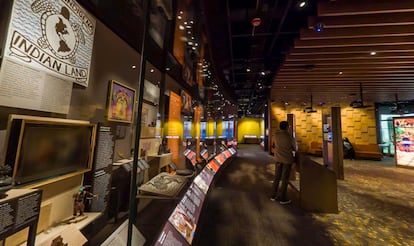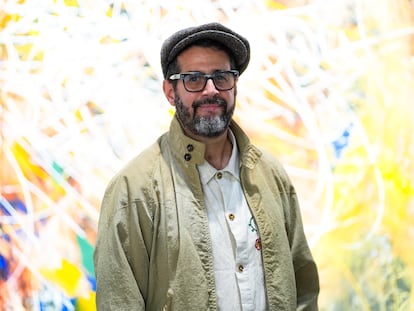‘You are what you see — and if you don’t see yourself in history, you don’t believe you’re part of that culture’
Smithsonian’s National Museum of the American Latino shows how the story of the United States is closely tied to that of Latin America


“The ¡Presente! A Latino History of the United States exhibition is important because it’s the first to present the experiences and historic perspectives of Latino communities in the United States as a fundamental part of U.S. history. For the first time, many visitors are seeing their communities represented in a museum,” says Ranald Woodaman, exhibitions and public programs director at Washington, D.C.’s National Museum of the American Latino.
The show offers a look at Latino figures who have had a major social, cultural, and historic impact on the country. It visibilizes lesser-known individuals, such as Latinas who may serve as inspiration for younger generations.
Visitors will find stories like that of Pura Belpré (1899-1982), a Puerto Rican children’s writer who became the first Latina to work in the New York City public library system. As a librarian, Belpré helped to create programs that reflect the cultural identity of Spanish-speaking young people.
But the exhibition also features more contemporary figures, such as Ellen Ochoa, a physicist and NASA astronaut born in 1958 and whose father was Mexican. She made history on two occasions, by becoming the first Latina to go to space in 1993, and by being the first Latina and second woman to direct the Johnson Space Center. Here too is Nuyorican judge Sonia Sotomayor, who in 2009 became the first Latina and third woman to serve on the Supreme Court.

Visitors to the ¡Presente! page on the museum’s website will encounter a digital gallery currently showing a 14-minute digital installation directed by Spanish-Venezuelan filmmaker Alberto Ferreras. The piece, entitled Somos, delves into Latino diversity and the complexity of assigning it a single identity, but also explores that which unites the term’s disparate groups. Because, as Woodaman points out, “what it means to be Latino is not crystallized. It is a plural identity that is still in formation, and it is up to us to build it, together.” The institution is attempting to create a cohesive history in which all communities are represented, while at the same time, establishing a universal throughline that unites them all, utilizing themes like the role of corn and the figure of grandmothers.
According to Emily Key, assistant director of learning and public engagement (whose father is Venezuelan and whose mother is from the United States, of Mexican heritage), the exhibition has received 736,000 visitors since its opening in June 2022, 50% of which have been a combination of students and multigenerational families, and the other 50%, adults with no dependants. “This is a museum by the community, for the community,” says Key by videoconference.
“You are what you see,” she continues. “If you don’t see yourself in history, you don’t believe you are part of that culture, and it is important that young Latinos see themselves represented in cultural institutions, in the programs that schools do, in the books they read and study. We have a duty to teach them that they are part of history, that they should be proud of their ancestors, and that they can contribute.”
“The Latino population is one of the largest minorities, it is the minority-majority, representing 20% of the population, which is about 63 million people,” Key says. “So it’s the duty of the National Museum as a Smithsonian institution to have those histories represented and made visible to the public.”
Even so, the National Museum of the American Latino, whose board of trustees includes Emilio Estefan, Sofía Vergara and Eva Longoria, still doesn’t have a permanent space. Since June 2022, it has occupied the Molina Family Latino Gallery in the National Museum of American History while it waits on the approval of legislation that will determine the location of its building. This is a lengthy process, and the museum is not expected to open its doors for another 10 to 12 years.
Add to this hurdle the fact that the museum’s content has already become the object of constant scrutiny. Last year, various conservative commentators criticized the current exhibition over its “Marxist” portrayal of Latinos as victims of an oppressive country. The New York Times and TIME pointed to this palpable political tension as the reason why the museum’s upcoming exhibit, which had been focused on the history of the Latino civil rights movement, was replaced with an exhibition that is expected to focus on the history of salsa music. ¡Puro Ritmo! The Musical Journey of Salsa will open in the spring of 2026.
Sign up for our weekly newsletter to get more English-language news coverage from EL PAÍS USA Edition
Tu suscripción se está usando en otro dispositivo
¿Quieres añadir otro usuario a tu suscripción?
Si continúas leyendo en este dispositivo, no se podrá leer en el otro.
FlechaTu suscripción se está usando en otro dispositivo y solo puedes acceder a EL PAÍS desde un dispositivo a la vez.
Si quieres compartir tu cuenta, cambia tu suscripción a la modalidad Premium, así podrás añadir otro usuario. Cada uno accederá con su propia cuenta de email, lo que os permitirá personalizar vuestra experiencia en EL PAÍS.
¿Tienes una suscripción de empresa? Accede aquí para contratar más cuentas.
En el caso de no saber quién está usando tu cuenta, te recomendamos cambiar tu contraseña aquí.
Si decides continuar compartiendo tu cuenta, este mensaje se mostrará en tu dispositivo y en el de la otra persona que está usando tu cuenta de forma indefinida, afectando a tu experiencia de lectura. Puedes consultar aquí los términos y condiciones de la suscripción digital.
More information
Archived In
Últimas noticias
The metaverse, four years later: Is it finished or just at a standstill?
$3,000 and a plane ticket: The United States increases incentives for migrants to self-deport before the end of the year
Charles Dubouloz, mountaineering star, retires at 36 with a farewell tour inspired by Walter Bonatti
From the White House to diplomatic gifts: Lego wins over adult fans, brick by brick
Most viewed
- The low-cost creative revolution: How technology is making art accessible to everyone
- Christian Louboutin: ‘Young people don’t want to be like their parents. And if their parents wear sneakers, they’re going to look for something else’
- All the effects of gentrification in one corner of Mexico’s Colonia Roma
- Christmas loses its festive spirit: ICE fears cast shadow over religious celebrations
- Liset Menéndez de la Prida, neuroscientist: ‘It’s not normal to constantly seek pleasure; it’s important to be bored, to be calm’










































